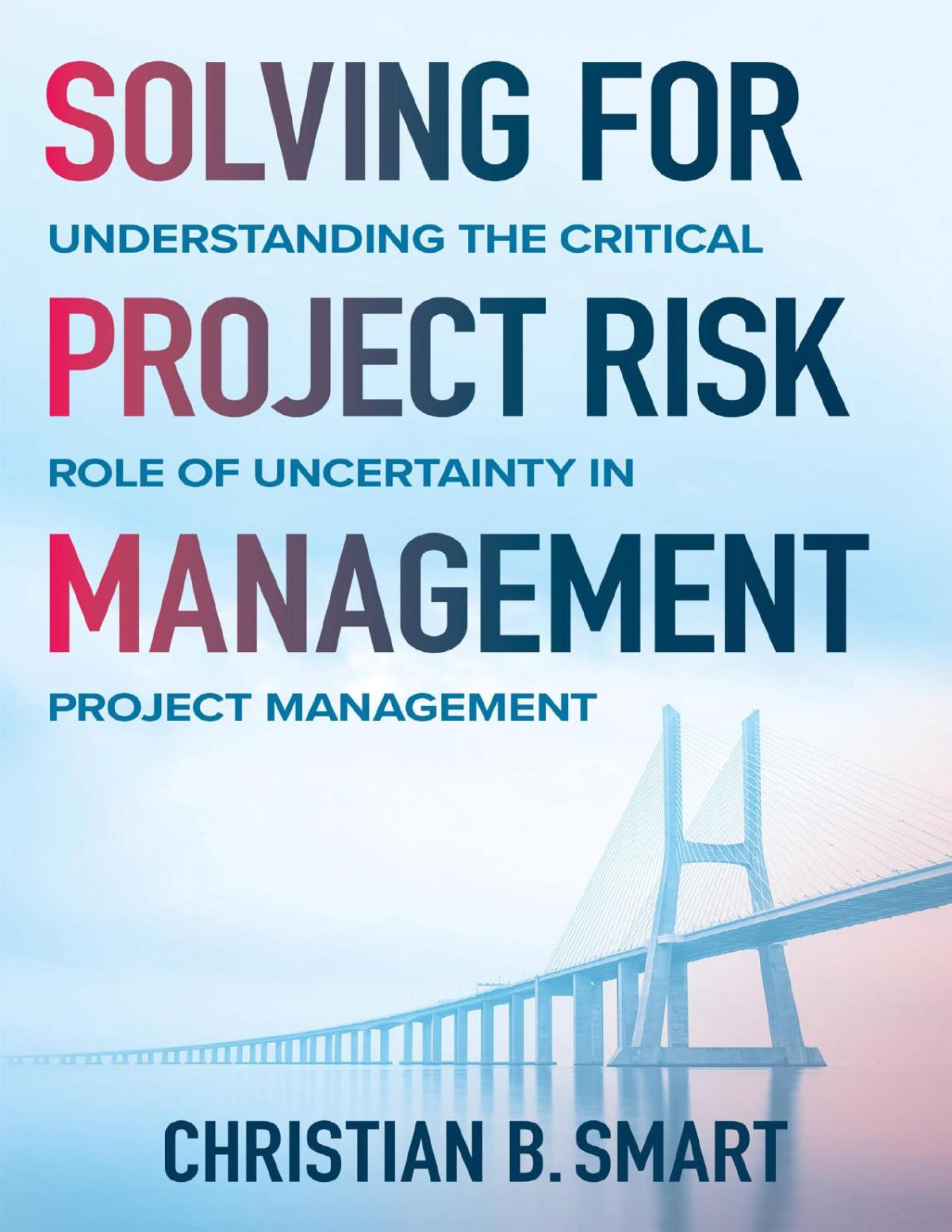Instant digital products (PDF, ePub, MOBI) ready for you
Download now and discover formats that fit your needs...
Solving for Project Risk Management Christian Smart
https://ebookmass.com/product/solving-for-project-risk-managementchristian-smart-3/
ebookmass.com
SOLVING FOR PROJECT RISK MANAGEMENT Christian Smart
https://ebookmass.com/product/solving-for-project-risk-managementchristian-smart/
ebookmass.com
Solving for Project Risk Management Christian Smart
https://ebookmass.com/product/solving-for-project-risk-managementchristian-smart-2/
ebookmass.com
Change in Strategy: An Office Romance (Change of Hearts Book 2) Sierra Hill
https://ebookmass.com/product/change-in-strategy-an-office-romancechange-of-hearts-book-2-sierra-hill/
ebookmass.com
John Hick's Religious Pluralism in Global Perspective
Sharada Sugirtharajah
https://ebookmass.com/product/john-hicks-religious-pluralism-inglobal-perspective-sharada-sugirtharajah/
ebookmass.com
I've Got You, Babe Lynnette Austin
https://ebookmass.com/product/ive-got-you-babe-lynnette-austin/
ebookmass.com
After Deportation: Ethnographic Perspectives 1st Edition Shahram Khosravi (Eds.)
https://ebookmass.com/product/after-deportation-ethnographicperspectives-1st-edition-shahram-khosravi-eds/
ebookmass.com
An Introduction to Clinical Trials 1st Edition Jonathan A. Cook
https://ebookmass.com/product/an-introduction-to-clinical-trials-1stedition-jonathan-a-cook/
ebookmass.com
Chemometrics in Spectroscopy (Second Edition) Howard Mark
https://ebookmass.com/product/chemometrics-in-spectroscopy-secondedition-howard-mark/
ebookmass.com
Manfred B. Steger
https://ebookmass.com/product/globalization-a-very-shortintroduction-6th-edition-manfred-b-steger/
ebookmass.com
Project Based Problem Solving and Decision Making
Copyright © 2024 by John Wiley & Sons, Inc. All rights reserved.
Published by John Wiley & Sons, Inc., Hoboken, New Jersey. Published simultaneously in Canada.
No part of this publication may be reproduced, stored in a retrieval system, or transmitted in any form or by any means, electronic, mechanical, photocopying, recording, scanning, or otherwise, except as permitted under Section 107 or 108 of the 1976 United States Copyright Act, without either the prior written permission of the Publisher, or authorization through payment of the appropriate per‐copy fee to the Copyright Clearance Center, Inc., 222 Rosewood Drive, Danvers, MA 01923, (978) 750‐8400, fax (978) 750‐4470, or on the web at www.copyright .com. Requests to the Publisher for permission should be addressed to the Permissions Department, John Wiley & Sons, Inc., 111 River Street, Hoboken, NJ 07030, (201) 748‐6011, fax (201) 748‐6008, or online at http://www.wiley.com/go/permission.
Trademarks: Wiley and the Wiley logo are trademarks or registered trademarks of John Wiley & Sons, Inc. and/or its affiliates in the United States and other countries and may not be used without written permission. All other trademarks are the property of their respective owners. John Wiley & Sons, Inc. is not associated with any product or vendor mentioned in this book.
Limit of Liability/Disclaimer of Warranty: While the publisher and author have used their best efforts in preparing this book, they make no representations or warranties with respect to the accuracy or completeness of the contents of this book and specifically disclaim any implied warranties of merchantability or fitness for a particular purpose. No warranty may be created or extended by sales representatives or written sales materials. The advice and strategies contained herein may not be suitable for your situation. You should consult with a professional where appropriate. Further, readers should be aware that websites listed in this work may have changed or disappeared between when this work was written and when it is read. Neither the publisher nor authors shall be liable for any loss of profit or any other commercial damages, including but not limited to special, incidental, consequential, or other damages.
For general information on our other products and services or for technical support, please contact our Customer Care Department within the United States at (800) 762‐2974, outside the United States at (317) 572‐3993 or fax (317) 572‐4002.
Wiley also publishes its books in a variety of electronic formats. Some content that appears in print may not be available in electronic formats. For more information about Wiley products, visit our web site at www.wiley.com.
Library of Congress Cataloging‐in‐Publication Data Applied for:
Hardback ISBN: 9781394207831
Cover Design: Wiley
Cover Image: © Konstantin Faraktinov/Shutterstock
Set in 9.5/12.5 STIX Two Text by Straive, India
Contents
Preface xi
About the Companion Website xiii
1 Understanding the Concepts 1
1.0 The Necessity for Problem-Solving and Decision-Making 1
1.1 Problems and Opportunities 2
1.2 Research Techniques in the Basic Decision-Making Process 3
1.3 Facts About Problem-Solving and Decision-Making 4
1.4 Who Makes the Decision? 4
1.5 Information Overload 5
1.6 Getting Access to the Right Information 5
1.7 The Lack of Information 6
Discussion Questions 6
References 7
2 Understanding the Project Environment and the Impact on Problem Solving 9
2.0 Understanding the Project Environment 9
2.1 Project Versus Business Problem-Solving and Decision-Making 11
2.2 Problem-Solving and Decision-Making in the Project Management Environment 11
2.3 The Impact of Constraints on Project Problem-Solving and Decision-Making 12
2.4 The Impact of Assumptions on Project Problem-Solving and Decision-Making 13
2.5 Understanding the Project Environment’s Complexities 14
2.6 Selecting the Right Project Manager 15
2.7 The Impact of the COVID-19 Pandemic on Project Management 15
2.8 Differences Between Program and Project Problem-Solving and Decision-Making 18
2.9 Problem-Solving in Matrix Management Organizational Structures 25
2.10 The Impact of Methodologies on Problem-Solving 29
2.11 The Need for Problem-Solving Procedural Documentation 35
Discussion Questions 40
References 41
3 Understanding the Problem 43
3.0 The Definition of a Problem 43
3.1 The Time Needed to Identify a Problem 43
3.2 Not All Problems Can Be Solved 45
3.3 The Complexities of the Problems 46
3.4 Techniques for Problem Identification 46
3.5 Individual Problem-Solving Conducted in Secret 47
3.6 Team Problem-Solving Conducted in Secret 47
3.7 Decisions That Can Convert Failures into Successes 48
Discussion Questions 53
References 54
4 Data Gathering 55
4.0 Understanding Data Gathering 55
4.1 Reasons for Data Gathering 56
4.2 Data-Gathering Techniques 56
4.3 Metrics and Early Warning Indicators 57
4.4 Questions to Ask 57
4.5 Establishing Structure for Data Gathering, Problem-Solving, and Decision-Making 58
4.6 Determining the Steps 58
Discussion Questions 59
5 Meetings 61
5.0 Problem Analysis Characteristics 61
5.1 Real Problems Versus Personality Problems 62
5.2 Determining Who Should Attend the Problem-Solving Meeting 63
5.3 Determining Who Should Attend the Decision-Making Meeting 63
5.4 Creating a Framework for the Meeting 64
5.5 Setting Limits on Problem-Solving and Decision-Making 64
5.6 Identifying Boundary Conditions 65
5.7 Understanding How People React in Meetings 65
5.8 Working with Participants During the Meetings 66
5.9 Leadership Techniques During Meetings 67
5.10 Handling Problem-Solving and Decision-Making Conflicts 67
5.11 Continuous Solutions Versus Enhancement Project Solutions 68
5.12 Problem-Solving Versus Scope Creep 68
8.11 Brainstorming Sessions: Team Idea Mapping Method 94
8.12 Brainstorming Sessions: Electronic Brainstorming 94
8.13 Brainstorming Sessions: Directed Brainstorming 95
8.14 Brainstorming Sessions: Individual Brainstorming 96
8.15 Question Brainstorming 96
8.16 Reasons for Brainstorming Failure 96
8.17 Virtual Brainstorming Sessions 98
Discussion Questions 100
9 Decision-Making Concepts 101
9.0 Decision-Making Alternatives 101
9.1 Decision-Making Characteristics 102
9.2 Decision-Making Participation 102
9.3 Understanding How Decisions Are Made 103
9.4 Cultures and Problem Solving 103
9.5 Routine Decision-Making 104
9.6 Adaptive Decision-Making 104
9.7 Innovative Decision-Making 105
9.8 Pressured Decision-Making 105
9.9 Judgmental Decision-Making 106
9.10 Rational Decision-Making 106
9.11 Certainty/Uncertainty Decision-Making 107
9.12 Controllable/Noncontrollable Decision-Making 107
9.13 Programmed/Nonprogrammed Decision-Making 108
9.14 Decision-Making Meetings 110
9.15 Decision-Making Stages 110
9.16 Decision-Making Steps 111
9.17 Conflicts in Decision-Making 112
9.18 Advantages of Group Decision-Making 113
9.19 Disadvantages of Group Decision-Making 113
9.20 Rational Versus Intuitive Thinking 114
9.21 Divergent Versus Convergent Thinking 114
9.22 The Fear of Decision-Making: Mental Roadblocks 115
9.23 Decision-Making Personal Biases 116
9.24 The Danger of Hasty Decisions 116
9.25 Decision-Making Styles 117
9.26 The Autocratic Decision-Maker 117
9.27 The Fearful Decision-Maker 118
9.28 The Circular Decision-Maker 119
9.29 The Democratic Decision-Maker 119
9.30 The Self-Serving Decision-Maker 120
9.31 Delegation of a Decision-Making Authority 120
9.32 Choice Elements of Decision-Making 121
9.33 Decision-Making Challenges 122
9.34 Examples of Decision-Making Challenges 123
Discussion Questions 126 References 127
10 Decision-Making Tools 129
10.0 Decision-Making Tools in Everyday Life 129
10.1 Use of Operations Research and Management Science Models 129
10.2 SWOT Analysis 130
10.3 Pareto Analysis 130
10.4 Multiple Criteria Decision Analysis 131
10.5 Paired Comparison Analysis 132
10.6 Decision Trees 132
10.7 Influence Diagrams 133
10.8 Affinity Diagrams 133
10.9 Game Theory 134
10.10 Cost-Benefit Analysis 134
10.11 Nominal Work Groups 135
10.12 Delphi Technique 136
10.13 Other Decision-Making Tools 136
10.14 Artificial Intelligence 137
10.15 Risk Management 140
Discussion Questions 142 References 142
11 Predicting the Impact 143
11.0 Evaluating the Impact of a Decision 143
11.1 Creating a Consequence Table 143
11.2 Performing Impact Analysis 144
11.3 The Time to Implement a Solution 145
11.4 The Definitions for Project Success and Failure Are Changing 145
11.5 Project Decision-Making and Politics 149
Discussion Questions 150
12 The Need for Effective or Active Listening Skills 151
12.0 Active Listening 151
12.1 Active Listening Body Language and Communications 151
12.2 Active Listening Barriers Created by the Speaker 152
12.3 Active Listening Barriers Created by the Listener 152
12.4 Overcoming Active Listening Barriers 153
12.5 Techniques for Effective Listening 153
Discussion Questions 154
13 Barriers 155
13.0 The Growth of Barriers 155
13.1 Lack of Concern for the Workers Barriers 157
13.2 Legal Barriers 160
13.3 Project Sponsorship Barriers 163
13.4 Cost of Implementation Barriers 165
13.5 Culture Barriers 166
13.6 Project Management Office (PMO) Barrier 168
13.7 Conclusion 169
Discussion Questions 169
References 170
Appendix: Using the PMBOK® Guide 173
Decision-Making and the PMBOK® Guide 173
Problem-Solving and the PMBOK® Guide 173
PMBOK® Guide: Integration Management 174
PMBOK® Guide: Scope Management 174
PMBOK® Guide: Time Management 175
PMBOK® Guide: Cost Management 175
PMBOK® Guide: Quality Management 176
PMBOK® Guide: Human Resource Management 176
PMBOK® Guide: Communications Management 177
PMBOK® Guide: Risk Management 177
PMBOK® Guide: Procurement Management 178
PMBOK® Guide: Stakeholder Management 178
Further Reading 181
Index 183
xii Preface
Hopefully, after reading this book, you will have a better understanding and appreciation for problem-solving and decision-making.
Seminars and webinars on project management, problem-solving, and decisionmaking can be arranged by contacting
Lori Milhaven, CSPO Executive Vice President, Strategic Programs International Institute for Learning
Harold Kerzner
Senior Executive Director for Project Management, International Institute for Learning, Inc. (IIL), USA
September 2023
About the Companion Website
This book is accompanied by a companion website: www.wiley.com/go/kerzner/projectbasedproblemsolving
The website includes instructor manual and chapter wise PowerPoints with extracts from the book for instructors
understanding of decision‐making is needed and used as part of identifying the problem and developing alternatives. This is why most books discuss problem‐solving and decision‐making together.
1.1 Problems and Opportunities1
Problem‐solving usually begins with the identification of a problem. A problem is a question raised for inquiry, consideration, or in need of a solution. Failure to meet product quality standards during manufacturing is a problem. Inventory shortages during a production run are a problem. Having resources assigned to a project that lack the necessary skills is a problem. These problems, if viewed positively, can become an opportunity for the astute manager rather than just a problem.
Not all problems require solutions. If you lack sufficient resources to maintain a schedule, senior management may allow the schedule to slip rather than hiring additional resources or reassigning resources from other projects that may have a higher priority.
An opportunity is a favorable chance for advancement or progress. If a company’s manufacturing process fails to produce a quality product, then the opportunity exists to improve product quality through
● Review of the product design process
● Analysis of manufacturing engineering standards
● Assessment of quality inspection techniques
● Evaluation of adequacy of manufacturing management
● Investigation of motivation and commitment of manufacturing personnel to implement adequate quality policies and procedures.
The difference between a problem and an opportunity depends on the beholder. However, problems and opportunities should be differentiated. David B. Gleicher, a management consultant, distinguished between the two terms in the following way: A problem is “something that endangers the organization’s ability to reach its objectives, while an opportunity is something that offers the chance to exceed objectives.”2
Peter Drucker made it clear that opportunities rather than problems are the keys to organizational and managerial success. He observed that solving a problem merely restores normality; but results must come from the exploitation of opportunities. He linked exploitation of opportunities to finding the right things to do and concentrating “resources and efforts on them.”3
1 This section has been adapted from Cleland and Kerzner (1986).
2 Cited in Stoner (1982).
3 Drucker (1964).
Identifying problems or opportunities is a key activity of all managers, including project managers. Successful managers do not wait for someone else to tell them what to do; they must find ways to figure that out for themselves. There are early warning signs and situations that can alert managers to possible problems (issues or opportunities). First, when the project team is expected to perform differently than they did in the past; second, when problems occur resulting from a deviation from an existing plan and no previous history exists; and third, when competitors are outperforming your organization.
1.2 Research Techniques in the Basic Decision-Making Process
Human performance in the way we address problems and make decisions has been the subject of active research from several perspectives. There has been significant research in this area, and most results are part of four perspectives. The four basic perspectives are:
● The psychological perspective
● The cognitive perspective
● The normative perspective
● The problem‐solving perspective.
From a psychological perspective, it is necessary to examine individual decisions in the context of a set of needs, preferences an individual has, and values desired. From a cognitive perspective, the decision‐making process must be regarded as a continuous process integrated in the interaction with the environment. From a normative perspective, the analysis of individual decisions is concerned with the logic of decision‐making and rationality as well as the invariant choices it leads to.
Yet, at another level that is perhaps more closely aligned with a project environment, it might be regarded as a problem‐solving activity which is terminated when a satisfactory solution is found. Therefore, decision‐making is a reasoning and/or emotional process which can be rational or irrational and can be based on explicit assumptions or tacit assumptions. It is often impossible to separate discussions of decision‐making from problem‐solving. Yet both involve selecting among alternatives. The focus of this book will be the problem‐solving perspective, although, in a project management environment, we could argue that all four perspectives somehow interact in the way we make decisions.
1.3 Facts About Problem-Solving and Decision-Making
There are several facts or generalities that we consider when discussing problem‐solving and decision‐making:
● Businesses today are much more complex than before and so are the problems and decisions that must be made.
● Problem‐solving techniques are used not only to solve problems but also to take advantage of opportunities.
● Today, we seem to be flooded with information to the point where we have information overload and cannot discern what information is actually needed or useful for solving problems.
● Lower to middle levels of management are often valuable resources to have when discussing the technical side of problems. Senior management is valuable in the knowledge of how the problem (and its solution) relates to the overall business and the impact of the enterprise environmental factors.
● Problem‐solving today is a core competency, yet most companies provide very little training for their employees on problem‐solving and decision‐making.
● The project team may be composed of numerous subject matter experts, but the same people may not be creative and capable of thinking creatively about solving problems.
● The people who created the problem may not be capable of solving the it.
● Few people seem to know the relationship between creativity and problem‐solving.
1.4 Who Makes the Decision?
Problem‐solving and decision‐making may not be performed by the same person. As an example, the project manager may ask the project team to assist in identifying alternatives for resolving a problem, or the project manager may perform the activities alone. However, the final decision on which alternatives should be taken may be made by executives, the project team, functional managers, or stakeholders. As such, when discussing decision‐making in this book, we use the word “manager” as the person making the decision, and it could represent different individuals other than the project manager. Usually, the people involved in the decision are the ones who will be affected by the outcome.
Behind every door in a company is information of some sort. Project managers must be able to open those doors as needed. If project managers do not have access to those doors, then there are two options: follow the chain of command and hope that the information is not filtered by the time it gets to you, or invite the person with this information to attend the problem‐solving meeting. Based on where the person with the information resides in the organizational hierarchy, their availability or willingness to attend the meeting is determined. The higher up they reside, the less likely they will be able to attend your meeting in the near term. The project manager’s accessibility to information is critical.
1.7 The Lack of Information
Even though we have information overload and access to secondary information sources, there is no guarantee we will have readily available all of the information we need. People that need to make decisions must accept the fact that they generally will not have all of the information they need on hand. This can happen at all levels of management, not just on projects. We must be willing to make the best possible decisions based upon the information we have at that time, even if it is partial information.
Too often, we rely on the chain of command for getting the information to help resolve a problem. If people believe that “possessing information is power,” access to the needed information can be a problem especially if they withhold some of the information. Because of the criticality of the project’s constraints, time is not necessarily a luxury. Project managers must have the right or authority to access those who possess the information. This assumes, of course, the project manager knows where the information resides. This is sometimes the greater challenge, especially if the needed information is nowhere to be found within the company. We must go outside the company to get the critical information.
Problem‐solving is most frequently based upon the best available information. Having all the information needed to make a decision is wishful thinking.
Discussion Questions
1. Why must problem‐solving and decision‐making be discussed together?
2. How do you differentiate between a problem and an opportunity? Can guidelines be established for differentiation?
3. When competitors are outperforming your organization, is this a problem, an opportunity, or possibly both?
4. Problem solving is considered as a “core competency” for future project managers. Why has this recognition not happened sooner?
5. In the future, will project managers be expected to make more or fewer decisions by themselves, and why?
6. What are the differences between primary and secondary information?
7. Why have project managers been challenged by not being able to get access to the right information in a timely manner?
References
Cleland, D.I. and Kerzner, H. (1986). Engineering Team Management. New York: Van Nostrand Reinhold, p. 229.
Drucker, P.F. (1964). Managing for Results. New York: Harper & Row, p. 5. Stoner, J.A.F. (1982). Management, 2. Englewood Cliffs, N.J.: Prentice‐Hall, pp. 166–167.
2 Understanding the Project Environment and the Impact on Problem Solving
made in the context of a project team’s activities should help the team members to decide
● What is to be done?
● How will it be done?
● Who will do it?
● Why is it being done?
● When is it to be done?
● Where will it be done?
It is through the decision process that a determination of future action for the team is made. The decision‐making process is a rational attempt to achieve results. Decision‐making encompasses both an active and passive use of resources.
An active decision is one made through full consideration of the existing mission, objectives, goals, and strategies and a sincere attempt to make effective and efficient use of resources. A passive decision also consumes resources. If a decision‐maker is not active in making a decision and procrastinates, organizational resources are consumed during the period of procrastination. If no deliberate decision is made, in reality, a decision has been made to do nothing. Resources continue to be consumed in the same manner that has been done in the past, often to the neglect of stakeholder consideration.
Stakeholders are the people, organizations, or institutions who contribute in some manner to or receive benefits from the decision. A product design team would have stakeholders composed of manufacturing, reliability, quality control, and design engineers plus representatives from customer service, marketing, and production control. Each of these professionals, as well as the organizations they represent, would have a vested and rightful interest in the decisions that are made in the design of the product. A decision made by the project team leader on behalf of the team should include stakeholder involvement. There is a valid reason for doing this. A decision must be implemented through a process of
● Delegation of appropriate authority and responsibility
● Allocation of human and nonhuman resources to support the decision
● Commitment of the people to make the decision workable
● Design a monitoring and control system such as the Earned Value Measurement System (EVMS) to determine if the decision is accomplishing the results that are desired.
Key decisions in modern organizations are influenced by laws, government regulations, environmentalists, and the actions or reactions of
● Competitors
● Suppliers
● Customers
● Collective bargaining units
● Employees










